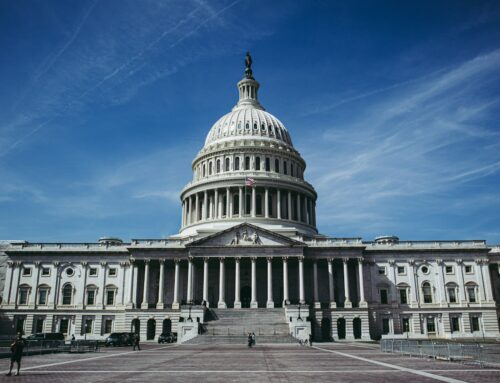Now that the House of Representatives has finally elected a Speaker, Congress can resume the people’s business. The federal government has been operating under a continuing resolution (CR) funding operations at fiscal year 2023 levels since October 1st. That CR expires November 17th, which means Congress must either pass the dozen FY2024 spending bills before then or enact another CR to avert a shutdown. But that’s not all that is on lawmakers’ plates. The farm bill, FAA reauthorization, and federal flood insurance program are amongst the major programs that expire with the CR as well. And as if that isn’t enough, the Biden Administration has added more to Congress’ immediate workload.
On October 20th the Biden administration sent Congress an updated $105.6 billion emergency supplemental spending request focused on aid to Ukraine, Israel, countering China and border security. Less than a week later they followed up with a separate request, close to $56 billion, for “critical domestic needs” such as disaster relief, free and lower-cost internet access, response to the fentanyl crisis and even more farm subsidies.
To put these unbudgeted emergency requests in perspective, the aggregate $161 billion request is two and half times larger than the entire Department of Homeland Security budget for FY2024, which came to just over $60 billion in discretionary spending, or triple the Department of Energy request, which came to $52 billion.
We broke down funding in the $105.6 billion emergency request by category in our initial analysis. Now, we’re on to scrutinizing some of the devils in the details, with special attention to ramped-up Pentagon spending for Ukraine.
In this latest emergency supplemental request, Pentagon spending on Ukraine aid dramatically increased from the administration’s previous request made in August, which was never enacted. Overall, in two months’ time the price tag jumped from $13 billion to over $44 billion, a 242 percent increase. In fact, the latest request includes more Pentagon spending than any of the previous Ukraine supplemental requests, which started at over $6 billion in Pentagon spending in March 2022, and got as high as $27.8 billion in December 2022.
The largest increase by category in terms of dollars was for the Defense-Wide Operations and Maintenance account, which jumped from about $9.9 billion in the August supplemental request to $30.6 billion in the latest package, a 210 percent increase. A small portion of the increase is also attributable to funding that wasn’t requested in August, including $117.5 million for Navy Weapons Procurement, $198.6 million for Defense Production Act Purchases, and $16.5 million for Army Research, Development, Test and Evaluation (RDT&E). Other programs included in the Administration’s August request saw increases as well, ranging from 12 percent to a whopping 1,413 percent.
Looking at all Pentagon spending on Ukraine aid since March 2022, this latest package, if enacted, would bring the total from just over $62 billion to just shy of $107 billion. All in, the defense, diplomatic, and humanitarian spending we’ve undertaken on an emergency budgeting process in response to Russia’s invasion of Ukraine is $113 billion before this latest request. A detailed accounting of previous supplemental spending in response to Russian aggression against Ukraine can be downloaded here.
One of our biggest questions has to do with what portion of this funding can reasonably be called “emergency” funding, as opposed to long-term investments that should just be part of the normal budget process. As the administration pointed out, the latest “supplemental request invests over $50 billion in the American defense industrial base,” funding that is mainly focused on ensuring adequate production of munitions so the U.S. can continue transferring munitions to allies while maintaining sufficient stockpiles at home.
The $30.6 billion requested for Defense-Wide Operations and Maintenance to support Ukraine includes $18 billion to replenish DOD stocks, reimburse the Pentagon for defense services and military education and training provided to Ukraine, and “to improve ammunition plants and equipment to increase the capacity and accelerate production of equipment to more rapidly replenish defense stocks.” The other $12 billion is for the Ukraine Security Assistance Initiative (though it bears mentioning that the request allows for up to $4 billion of the $30.6 billion in this category to be transferred between the Ukraine Security Assistance Initiative and the funding for replacing Pentagon stocks).
In the first year of the Russia-Ukraine war, using emergency funding to ramp up munitions production seemed more justifiable, but now, over a year and a half into the conflict, the administration’s assertion that “this funding arises from unforeseen and unanticipated events” is more dubious.
To be clear, this isn’t a value judgement on the funding itself. Rather, we’re questioning the vehicle for this funding, and flagging the tendency for emergency funding packages to fund priorities that could have been anticipated and funded in the normal budget process. That normal process, which the administration and Congress go through each year, allows taxpayers and their representatives in Congress to weigh funding priorities against each other and consider the nation’s resource constraints, whereas lumping this industrial base funding in with genuine emergency funding sidesteps much of the scrutiny and accountability that the normal budget process allows for.
As Congress weighs this request and works to pass a budget for the coming fiscal year, and as the administration begins preparing for its FY2025 budget request, we’ll continue keeping an eye on this kind of funding and keep you posted on any developments.











Get Social